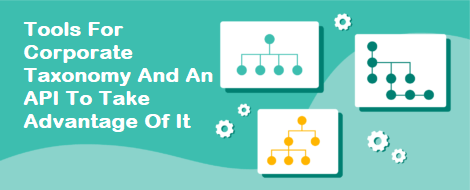What does a corporate taxonomy actually mean? Despite some authors’ best efforts, it is difficult to define the term “taxonomy”. The majority of the definitions offered thus far apply to documentary languages; including thesauri, categorization schemes, and other types of controlled vocabularies, ranging from rings of synonyms to ontologies and catalogs of authority. Continue reading Tools For Corporate Taxonomy And An API To Take Advantage Of It for more information. We’ll also introduce you to the IAB Tech Lab’s Content Taxonomy, which you can use in your organization.
Some nuances that affect the divergence of the types of tools:
• The corporate taxonomy is helpful to organize all kinds of digital content in an integrated manner: unstructured data; processed information; information about people; services and products; computer applications; email messages, etc. For example, we can consider a bottle of wine as content in the corporate environment, just like a magazine article. The two informative objects have characteristics that allow us to describe them and include them in an organized structure to facilitate their retrieval. Besides, this broad sense of the concept of “digital content” also includes the integration of different formats and morphologies of information; associated with different applications and access to different users based on permissions and other accessibility issues.
• The corporate taxonomy is designed not only to index or classify the resource or content with a view to being retrieved exactly through a search in the system but is also considered a structure that allows its exploitation by different types of applications, although the current trend places more importance on its ability to obtain category structures that facilitate navigation. However, these structures can be useful fo exploration and navigation aid systems, search engines, information filtering, and personalization systems, by data mining applications, competitive research, collaboration between experts, etc. In other words, the taxonomy is not only a knowledge structure but also allows the development of applications and incorporates specific content.
Some info…
Even though the principles that guide the structure are the same as those that can be found in a thesaurus —control of vocabulary and relationships between concepts—, the differences discussed so far were reason enough for the year 2000 -yes, more than 20 years!- A review of the North American monolingual thesaurus construction standard, ANSI/NISO Z39.19–1994, will be initiated.
The purpose of this review is to adapt the standard to the new situation, in which conceptual structures are needed that incorporate the requirements set forth by the organizations and by the new information access environment (browsing on the WWW), as well as guidelines that facilitate access to information without intermediaries plus the construction of conceptual structures by people outside the field of librarianship and documentation.
As we can read in the public documents about the revision of the standard; the objective of turning it into a guideline to elaborate on various types of interoperable conceptual structures is declared: thesauri, classification systems, controlled vocabularies, rings of synonyms and taxonomies, among others.
Check Text Classification IAB Taxonomy: A Corporate Taxonomy API To Take Advantage Of
The Content Taxonomy has evolved over time to provide publishers with a consistent and easy way to organize their website content. For example, to differentiate “sports” vs. “news” vs. “wellness” material. IAB Tech Lab’s Content Taxonomy specification provides additional utility for minimizing the risk that content categorization signals could generate sensitive data points about things like race; politics, religion, or other personal characteristics that could result in discrimination.
While the Content Taxonomy itself doesn’t constitute sensitive data; – it simply categorizes page content, and does not on its own reveal information about a user –; there are few technical controls preventing taxonomy nodes from associating with individual IDs to build behavioral profiles over time based on content preferences.

Some frequently asked questions…
What this API receives and what your API provides (input/output)? Just pass the text that you want to categorize and you will get its IAB taxonomy. Simple as that!
What are the most common uses cases of this API? This API is going to help those companies with a large amount of data that need to sort it by category. Thus, you will be able to gather text by grouping it by category. Besides, ideal for marketing agencies that want to extract data online and want to categorize it as well. Also, helpful to classify sentences or slogans, you will get the exact categorization in IAB standards.
Are there any limitations with your plans?
Besides API call limitations per month:
Testing Plan: 5 requests per second.
Basic: 10 requests per second.
Pro: 30 requests per second.
Pro+: 60 requests per second.


